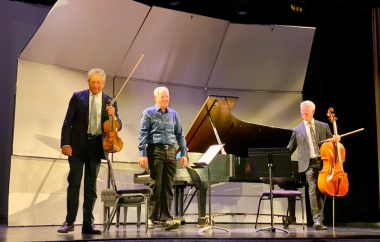 United States Legion Chamber Music – J. S. Bach, Schubert: Alexander Barantschik (violin), Peter Wyrick (cello), Anton Nel (piano and harpsichord). Presented by San Francisco Symphony, Gunn Theater at the Legion of Honor, San Francisco, 3.12.2023. (HS)
United States Legion Chamber Music – J. S. Bach, Schubert: Alexander Barantschik (violin), Peter Wyrick (cello), Anton Nel (piano and harpsichord). Presented by San Francisco Symphony, Gunn Theater at the Legion of Honor, San Francisco, 3.12.2023. (HS)

J. S. Bach – Sonata No.3 in E major for Violin and Harpsichord; Sonata No.3 in G minor for Viola de Gamba and Harpsichord
Schubert – Piano Trio No.1 in B-flat major
Four times a year, Sunday concerts at the Gunn Theater in San Francisco find select San Francisco Symphony musicians doing well-known works by the usual composers, from Mozart to Schubert to Shostakovich. This Sunday’s event took a bit of a detour with a couple of Bach sonatas rarely heard from performers not dedicated to early music.
The chamber series, in its twenty-second year, stems from a bequest by the celebrated violinist Jascha Heifetz, who left his Guarneri ‘del Gesu’ instrument, the ‘David’, to the Fine Arts Museums of San Francisco at his death in 1987. He wanted the instrument to be played by ‘worthy musicians’. It was decided that it would be the regular instrument for the concertmaster of the San Francisco Symphony, and at this newly created chamber music series at the Legion of Honor in Lincoln Park, which overlooks the Golden Gate Bridge.
Colleagues in the orchestra have joined concertmaster Alexander Barantschik for the series in the museum’s ornate, 316-seat auditorium. Longtime visiting pianist, Anton Nel, flies in from his home in Austin, Texas, where he chairs the piano department at the University of Texas and from which he tours the world as soloist and playing chamber music. Of late, he has added harpsichord to his repertoire.
Nel was not the only one playing a different instrument than usual. Peter Wyrick, associate principal cellist in the orchestra, deployed a special cello with a fifth string to better execute the extended range of a Bach sonata for viola da gamba (which usually has six).
The results of all were enchanting. The Sonata No.3 for Violin and Harpsichord, with its freer-than-usual harmonies and relaxed counterpoint, made a perfect appetizer. If Barantschik employed a bit more vibrato than many early-music sticklers might allow, the sound on the famous violin paid dividends, especially in the instrument’s richly endowed low range in the slow first and third movements.
The interplay between Barantschik and Nel in the faster allegros, especially the bouncy finale, brimmed with an intricate interlacing of rapid counterpoint.
For his part, Wyrick favored more straight-tone sound in the da gamba sonata, lightening his tone and, when appropriate, taking advantage of the extra high string to play the notes with a silvery cast. The opening vivace danced deftly and, after a sweet adagio, the allegro finale indulged in some back-and-forths that were almost jazz-like in the way they tossed the musical gestures to each other.
After intermission, it was back to a classical chamber music staple with Schubert’s Piano Trio No.1 in B-flat. The sunny piece has its challenges for musicians, who must find a balance between bouncy tunes and seemingly guileless forms that take detours into false starts and sudden key changes.
It all went down well, especially in the Scherzo, when the quick shifts in rhythm and the contrast with the sweetly airy trio struck just the right tone. The musicians found pace and gestures to make it elegant without losing Schubert’s sly humor. The finale reveled in the unexpected variations as the themes return in the rondo form and brought things to a resounding climax with a zingy coda.
Harvey Steiman
